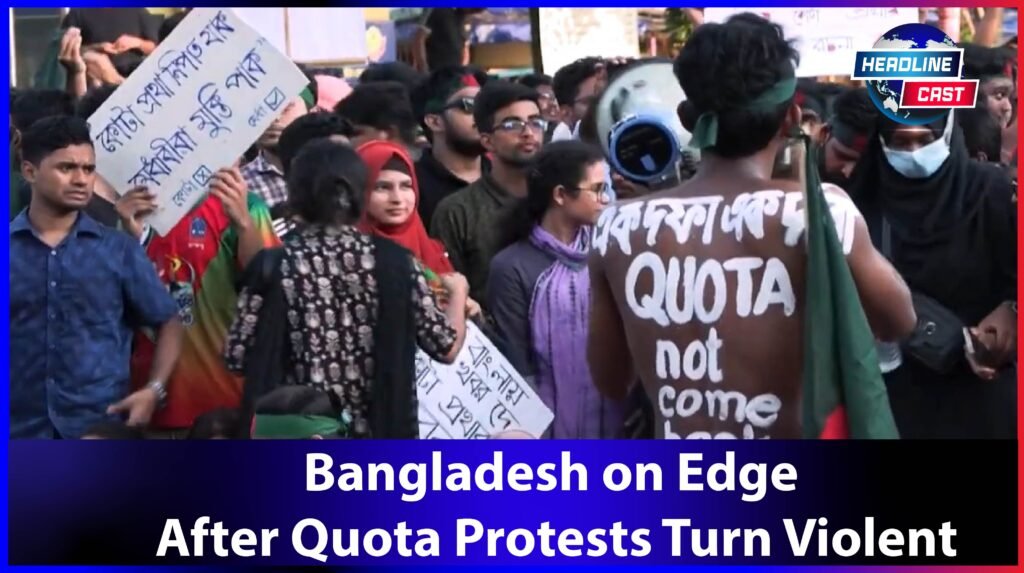
This incident was one of many tense altercations that have erupted across Bangladesh’s universities in recent days, as students protested against a recent High Court decision to reinstate a controversial quota system in government jobs. This quota system, abolished in 2018 following widespread protests, has been reinstated, igniting anger and frustration among many young Bangladeshis seeking government jobs, who believe their chances have been diminished by the quotas.
Protests Escalate
The protests escalated dramatically late on Sunday night, with thousands of students across the country leaving their dormitories to demand the immediate elimination of quotas. On Monday, university campuses turned into battlegrounds, with heavily armed BCL activists clashing with students protesting the quota system. Hundreds of students were injured.
Namlah narrowly escaped harm during the afternoon, but later that night, she found herself trapped in a small room with a dozen others inside the vice chancellor’s residence compound. The students allege that BCL activists hurled bricks and even petrol bombs at them.
“We thought we wouldn’t make it out alive,” Namlah recounted. “Neither the police nor the university administration came to help us. Eventually, our fellow protesters gathered in large numbers and rescued us, but several of us were seriously injured.”
Wearing helmets and wielding sticks and iron rods, hundreds of BCL members, many reportedly from outside DU, assaulted protesters throughout the campus. Students were left bruised and bloodied. “We were peacefully marching in the DU campus, but all of a sudden the Chhatra League activists attacked us with sticks and even machetes,” one female DU student told Al Jazeera, requesting anonymity.
A group of Awami League supporters even stormed the emergency department of Dhaka Medical College Hospital in the evening, where injured students were receiving treatment. The attack caused widespread panic among doctors, nurses, patients, and visitors, and disrupted medical services at the country’s leading medical facility.
Government and BCL Response
However, BCL president Saddam Hossain insisted that the student body had been provoked.
“Those who openly identify as ‘Razakar’ must face consequences. Such individuals have no place in this country, and we have decided to politically confront the students protesting quota reforms,” Hossain stated during a media briefing on Monday.
Hossain was referring to a late-night protest on Sunday where students were chanting slogans in Bengali, meaning “Who are you? Who am I? Razakar, Razakar!” and “We sought rights, but we’ve been labelled as Razakars”.
Earlier that Sunday afternoon, Prime Minister Sheikh Hasina had also referenced Razakars — collaborators with the Pakistani Army in 1971, when up to three million people were killed and millions more were displaced, including to India, during the creation of Bangladesh.
“If the grandchildren of freedom fighters don’t receive quota benefits, should the grandchildren of Razakars?” Hasina said.
Hasina’s remark offended protesting students and job seekers who have been demonstrating against the 30 percent quota reserved for family members of freedom fighters from the 1971 Bangladesh Liberation War. They believe this quota unfairly limits their opportunities and are suspicious of the accuracy of the beneficiary list.
Explaining the students’ reaction, Nahid Islam, a spokesperson for the protesters, clarified that they were being sarcastic when they chanted the Razakar slogan, in direct response to the PM’s comment.
But the Bangladesh government has questioned that explanation. Mohammad A Arafat, state minister for information, told Al Jazeera that until Monday, neither the Awami League nor the BCL had tried to counter the student protesters.
“Students self-identifying as Razakar” is what provoked them, he said, adding that BCL members had also been injured in the campus clashes. Yet Asif Nazrul, a law professor at Dhaka University, told that the message the students intended to convey through their slogans was clear. “I doubt any student at Dhaka University would identify themselves as Razakar,” he remarked.
Nazrul also criticized the government’s response, suggesting they were eager to suppress the ongoing protests and had found a convenient pretext to do so.
Quota systems in government jobs were originally introduced to ensure representation and inclusion. Established in 1972 for freedom fighters, the quota system was discontinued but reinstated in 1996. Currently, 56 percent of government jobs are reserved for specific groups, including the largest share of 30 percent for freedom fighters’ descendants, women, minorities, and people from districts lagging on socio-economic indices.
The Quota System Debate
This system has long been criticized for excluding other qualified candidates and leaving positions unfilled if designated candidates fail recruitment tests.
In 2018, amid an earlier bout of quota reform protests, Prime Minister Hasina abruptly abolished quotas in public service recruitment to quell unrest. However, this decision was met with criticism for neglecting historical injustices and marginalizing certain groups. Recently, the High Court ruled in favor of freedom fighters’ dependents, arguing that the quota removal violated their rights established in a previous court verdict.
Saiyed Abdullah, a law graduate and activist, stated there was a misconception about the students’ demands. “The students protesting are not pushing for the complete abolition of quotas; rather, they are advocating for a reasonable percentage of quotas” for traditionally disadvantaged communities, he said.